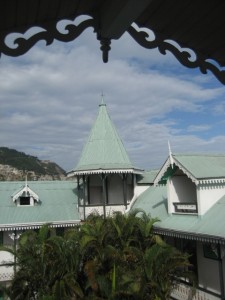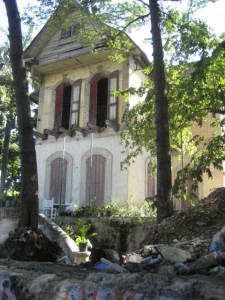The Grandes Dames of Port-au-Prince

Architectural detail – The Kinam Hotel
In Haiti at the end of our first day, when we’d ridden back into Port-au-Prince and I’d sponged off most of the village sweat and grime that I’d accumulated over the past several hours, I sat in the courtyard of our hotel, cold beer in hand, and realized that I was being quietly seduced by the charm of the gingerbread architecture surrounding me.
The Kinam Hotel where we were staying is one of Port-au-Prince’s grandes dames of Victorian-style gingerbread architecture in the city. Miraculously, of the nearly 200 gingerbreads in Port-au-Prince before the 2010 earthquake, nearly all survived. Their wooden frames and structure had the just enough “give” to withstand the tremors, whereas rigid rebar and concrete buildings crumbled, 40 percent of the total being reduced to rubble. Having withstood the ravages of time and weather for over 100 years, what was a little 30 second rumble?
Gingerbread Victorian homes became popular in Haiti in the latter part of the 19th century. Native born, Parisian educated architects returned to their Caribbean homeland and plied their trade with relish. The style was florid, communicating the good life. Painted in vibrant tropical hues, they nonetheless had their practical elements. High ceilings and turreted roofs directed hot air above the inhabitable space, windows on all sides created a cool cross-breeze even during seasonal stretches of blistering heat, and the frame’s tractability enabled them to weather powerful storms. The only drawback was their combustibility. Fires ravaged the city of Port-au-Prince not infrequently, and the gingerbreads added a great deal of fuel to the flame. So much so in fact, that in 1910, new construction of gingerbreads came to be forbidden by mayoral decree.

Another gingerbread gem
In the ensuing years, the gingerbreads remained an iconic symbol of gracious living and were treasured by tourists and the local populace alike. However, as the economy faltered and the Haitian diaspora came into full swing, those with knowledge of gingerbread construction took it with them, leaving a void in the ability to keep them maintained and viable. Complicating matters further was the diminishing supply of hardwood material leaving little with which to repair them. Consequently, the lovely gingerbreads of a bygone era are falling apart, collapsing not by a single catastrophe, but bit by bit, plank by shingle.
There is a movement afoot to preserve the remaining grand dames. Ironically, three months before the
![rnd383[1]](https://blog.itscactus.com/wp-content/uploads/2012/12/rnd3831-280x300.jpg)
How about this grande dame? RND 383 by Charles Luthene
Haitian heavy-hitters have also rallied to the cause, among them the former president, Michele Pierre-Louis and Jean-Julien Olson, the former cultural minister. In the gingerbreads they see potential for restoration not only of their beautiful forms, but of the national cultural history they represent. Backing by the current Haitian government, in the form of legislation blocking demolition, is unfortunately, yet to be enacted.
(Go to the website below and click on the video for further insight)
http://www.aljazeera.com/focus/2010/08/2010823746741174.html
Still, there is hope. Says Olson, “These old homes are a reflection of the Haitian people. Just look how they stand facing the street. They provide space for people to meet and greet each other. That’s the way our society works. We need to remember that. We talk about building back better, but the whole key to that success is to remember our past.”
Contributed by Linda for Beyond Borders/Its Cactus
